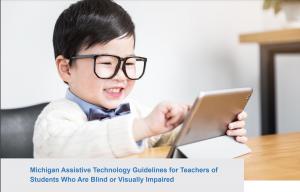The Michigan Assistive Technology Guidelines for Teachers of Students Who Are Blind and Visually Impaired
Submitted by Charlotte Cushman on May 13, 2021

The Michigan Assistive Technology Guidelines for Teachers of Students Who Are Blind and Visually Impaired is a series of documents for teachers of students who are blind or visually impaired in pre-kindergarten through grade 12.
These guidelines follow six key concepts:
- Technology Operations and Concepts
- Creativity and Innovation
- Communication and Collaboration
- Critical Thinking and Problem Solving
- Research and Information Technology
- Digital Citizenship
Guidelines
The assistive technology (AT) guidelines provide information on AT devices, data collection, individualized education programs (IEPs), reporting, resources, professional development, and the AT industry. Teachers may use these guidelines to develop IEP goals, develop lesson plans, and track technology instruction progress.
Each guideline document includes:
- The skill the student will perform and the suggested teacher activity for each skill
- Columns to track a student's progress with each skill; each student should have a copy of the checklist in his or her school file
- AT glossary
- AT resources
- Tool and application sample listing
- Tool record-keeping chart
